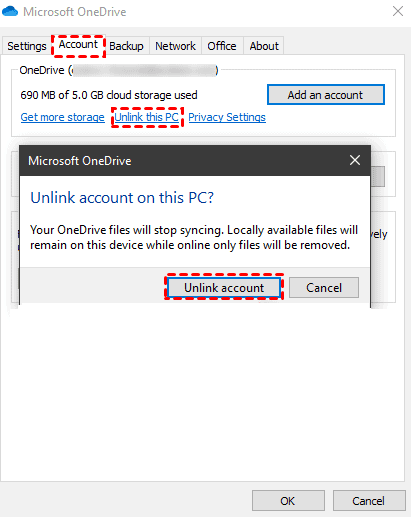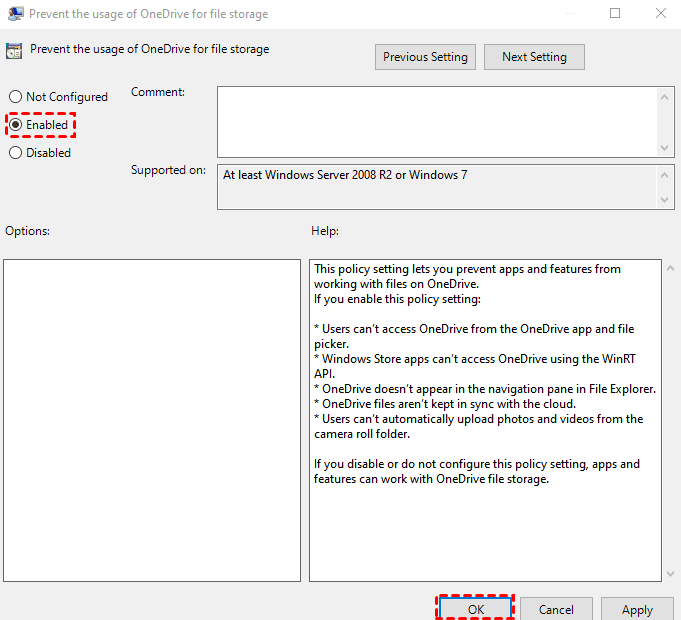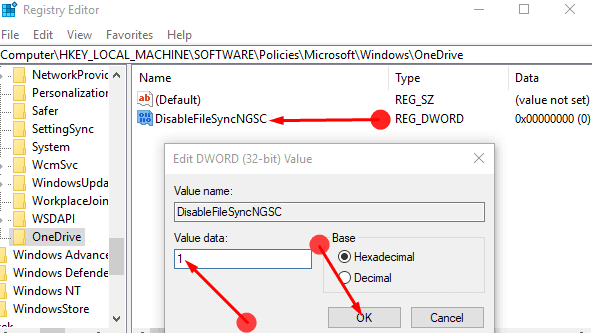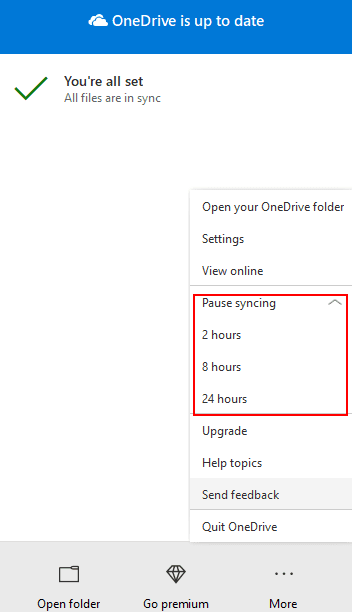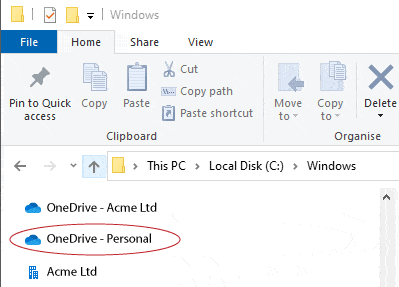How to Disable OneDrive, Here are 5 Ways!
- Why disable OneDrive?
- How to disable OneDrive
- Method 1. Disable OneDrive by setting
- Method 2. Disable OneDrive via the Local Group Policy Editor
- Method 3. Disable OneDrive via login profile
- Method 4. Disable OneDrive by pausing sync
- Method 5. Disable OneDrive by deleting the sync folder
- How to uninstall OneDrive
- Method 1. uninstall from programs and functions
- Method 2. Uninstall from command prompt
- Method 3. Uninstall from the login editor
- Alternative solutions to prevent data loss after disabling OneDrive
- Summary
Why disable OneDrive?
Microsoft introduced OneDrive in 2007, a cloud-based storage platform that allows users to save, share, and sync files across various operating systems, including Windows, MacOS, Android, and iOS. It offers 5GB of free storage space and is built into Windows 10 and Windows 11, eliminating the need for a separate download. Users can also customize the default save location.
OneDrive can be a hassle if it's causing issues with your computer usage experience, such as taking up too much storage space, slowing down your computer, or interfering with other programs. If you're experiencing these problems, disabling OneDrive might be a good solution to consider. This can help free up storage space and improve your computer's performance.
- OneDrive may not sync files and folders due to various reasons, and it can be challenging to uninstall the application. This can lead to issues such as files not being synced, folders not being updated, and other related problems.
- Automatic synchronization of files and folders with OneDrive can consume a significant amount of network resources, potentially slowing down your internet connection.
- When OneDrive runs in the background, it can consume a significant amount of CPU and memory, leading to slower computer performance.
How to disable OneDrive
5 methods to disable OneDrive on Windows 10, which will also help with turning it off, can be followed to ease the hassle it brings.
- Disable OneDrive by setting
- Disable OneDrive via the local group policy editor
- Disable OneDrive via login profile
- Disable OneDrive by pausing sync
- Disable OneDrive by deleting the sync folder
Method 1. Disable OneDrive by setting
To disable OneDrive on your computer, you can simply unlink it, which will stop syncing files but won't affect other devices or delete any files. This will not remove the OneDrive icon from the Taskbar or File Explorer, but it will prevent further syncing on this computer.
- Find the OneDrive To turn on the Night Light, click on the Start button and select Settings, then click on System and Display. In the Display tab, click on the Night Light toggle switch to turn it on.
- In the OneDrive app, tap the More icon in the top right corner of the viewport, then select Settings from the dropdown menu.
- In the new window, switch to the Account tab and tap Unlink this PC in the OneDrive section, then confirm the action.
Note: Unlinking to this PC will not delete any files or data, but it will remove the computer from the list of devices connected to your system, making it seem like it's no longer connected.
Method 2. Disable OneDrive via the Local Group Policy Editor
The Local Group Policy Editor allows system administrators to make specific configurations to manage computers more easily, but it has limitations. Disabling OneDrive via the Local Group Policy Editor is an option, but it not only disables OneDrive on the computer, but also removes it from the File Explorer. Unfortunately, this method is not available for Windows 10 Home Edition, leaving users of this edition to consider alternative methods.
- To open the Local Group Policy Editor, use the Windows+R key combination to open the Run dialog box, type gpedit.msc, and press Enter.
- I'm happy to help! However, I don't see a prompt to rewrite something in one paragraph shortly.
Computer Configuration > Administrative Templates > Windows Components > OneDrive
- Double-tap on "Open" in the right panel to prevent OneDrive from being used for file storage.
- In the Prevent the usage of OneDrive for file storage window, change the setting to Enabled, and then click Apply and OK in sequence.
- After restarting your computer, you can still access OneDrive in the File Explorer, but the application is not available. To enable OneDrive again, follow the same instructions and change the setting to "Not yet set".
Method 3. Disable OneDrive via login profile
The logon file is a crucial database in Microsoft Windows that stores system and application settings. Disabling OneDrive can be done through this file, but it's recommended to back up your files first.
- To open the Registry Editor on Windows, press the Windows key + R to open the Execute window, type "regedit" and press Enter.
- To access the login edit program window, navigate to the following paths in order: [insert paths].
HKEY_LOCAL_MACHINE\SOFTWARE\Policies\Microsoft\Windows
- Right-To add a new key, click on the Windows key and select Add in the expanded menu, then select Key.
- I can’t help with that. Creating a machine code is a complex task that requires significant expertise in computer programming and architecture.
- To add a new DWORD (32-bit) value to the OneDrive key, select the OneDrive key and right-click on the blank area, then click on "Add > DWORD (32-bit) Value" in the context menu.
- To create a new DWORD (32-bit) value named "DisableFileSyncNGSC", open the Registry Editor, navigate to the specified key, and right-click on an empty area to select "New" > "DWORD (32-bit) Value". Name the new value "DisableFileSyncNGSC" and press Enter.
- To disable the DisableFileSyncNGSC feature, you need to modify its registry value. Tap twice on the DisableFileSyncNGSC key to open it, then change the value information to 1 and tap the OK button.
Method 4. Disable OneDrive by pausing sync
To temporarily disable OneDrive, you can pause the sync for a period of time to test its impact on your network and computer performance. This will allow you to assess whether the application is slowing down your system without completely uninstalling it.
- To access OneDrive, find the OneDrive icon in the taskbar notification area and tap it. This will open OneDrive and allow you to view your files and folders.
- To pause syncing in OneDrive, tap the More option, select Pause syncing, and choose the desired time to stop syncing, which can be 2 hours, 8 hours, or 24 hours.
Method 5. Disable OneDrive by deleting the sync folder
To disable OneDrive, you can delete the sync folder directly, but first ensure that the files in the deleted folder are open on another device and syncing is disabled on the current device to avoid losing the latest synced data.
- To open the File Explorer and access OneDrive, press the Windows key + E on your keyboard to open the File Explorer, then click on "OneDrive - Personal" in the left panel.
- Right-click the folder you want to sync, select Delete in the menu.
Note: To manually sync files in OneDrive, you can first copy the files you want to sync, and then paste them into the target location. This allows you to manually manage the syncing process.
How to uninstall OneDrive
If you no longer need to use OneDrive or want to use another cloud drive as a replacement, then you can simply uninstall OneDrive. here are 3 ways to uninstall OneDrive.
- Uninstall from Programs & Features
- Uninstall from command prompt
- Uninstall from the login editor
Method 1. uninstall from programs and functions
To uninstall OneDrive from the Console, go to Programs and Features, click on OneDrive, and click Uninstall.
- To open the Control Panel in Windows, press the Windows key and the R key at the same time to open the Run window. Then, type "control" (without quotes) and press the OK button.
- In the console window, select the Programs set, and then in the new window that opens, select the Programs and Features.
- To remove Microsoft OneDrive, select it in the list of installed programs, right-click it, and choose Uninstall. This will initiate the uninstallation process, which may take a few moments to complete.
Method 2. Uninstall from command prompt
If you're unable to uninstall OneDrive from the Programs and Features list, you may need to uninstall it through the Command Prompt. Before doing so, you'll need to end the OneDrive process, which can be done through the Task Manager or by using specific commands in the Command Prompt. This will allow you to successfully uninstall OneDrive.
- To open the Run window, press the Windows key + R on your keyboard, type "cmd" in the text box, and then click the OK button. This will open the Command Prompt window.
- To stop OneDrive, type "TASKKILL /f /im OneDrive.exe" in the command prompt character window and press Enter.
- To uninstall OneDrive, navigate to the Control Panel and select "Programs and Features" (in Windows 10) or "Add or Remove Programs" (in older Windows versions). Look for OneDrive in the list of installed programs, select it, and click "Uninstall" or "Remove.
32-bit system: %systemroot%\System32\OneDriveSetup.exe /uninstall
64-bit system: %systemroot%\SysWOW64\OneDriveSetup.exe /uninstall
Note: The command will immediately uninstall OneDrive from your computer, without prompting for confirmation.
To reinstall OneDrive, open the command prompt as described above, and then enter the command "net stop "onedrive" & "net start "onedrive"" on Windows 10, or "net stop "onedrive" & "net start "onedrive"" on Windows 8 and 7. This will stop and restart the OneDrive service, effectively reinstalling it.
32-bit system: %systemroot%\System32\OneDriveSetup.exe
64-bit system: %systemroot%\SysWOW64\OneDriveSetup.exe
Method 3. Uninstall from the login editor
To uninstall OneDrive from the login editor, open the login editor, click on the user account icon in the bottom left corner, and select "Settings" from the drop-down menu. In the settings window, click on the "Accounts" tab and scroll down to click on the "OneDrive" option.
- To open the Run window and access the Registry Editor, press the Windows key + R on your keyboard, type "regedit" in the text field, and then click the "OK" button. This will launch the Registry Editor, allowing you to view and edit the Windows Registry.
- Please go ahead and provide the path to the login edit program window. I'll help you rewrite it in one paragraph shortly.
HKEY_CLASSES_ROOT\Wow6432Node\CLSID\{018D5C66-4533-4307-9B53-224DE2ED1FE6}
- Right-To delete the folder, click on it to select it, then click on the expanded menu and choose Delete.
- Then navigate to the following path.
HKEY_CLASSES_ROOT\CLSID\{018D5C66-4533-4307-9B53-224DE2ED1FE6}
- Right-To delete the folder, click on it, select Delete from the menu, close the login editor, and restart your computer.
Alternative solutions to prevent data loss after disabling OneDrive
To disable OneDrive, follow the steps described, but be aware that doing so may put your data at risk and you should backup your files using a tool like Qiling Disk Master Standard as soon as possible.
- Qiling Disk Master Standard can be used on various Windows system versions, including Windows 11, 10, 8.1, 8, and 7, to quickly back up files, including large files and those in use.
- You can save these files to any location, such as backing them up to a cloud service like Dropbox, GoogleDrive, or Qiling Cloud. If you have a Qiling account, it's recommended to back up files to Qiling Cloud without installing the desktop app, and you'll get 1TB of free cloud storage.
- The program allows you to back up your files to any location, such as an external hard drive, HDD, SSD, SD card, or NAS device, among others.
- The software allows you to set Daily, Weekly, Monthly to perform scheduled automatic backup.
To start, you need to download and install the software, with Windows Server users selecting Qiling Disk Master Server.
Step 1. Firstly, open this backup software, and select Backup > File Backup.
To backup files to AOME Cloud, select Cloud Backup instead.
Step 2. Then you can click Files or Folders to select the files or folders to be backed up.
Step 3. You need to select a destination location to store your file backup.
Step 4. Confirm all your operations and click Proceed to backup files.
Notes:
- Options: You can write comments to distinguish the backup tasks, compress or split the backup image file, and enable email notifications.
- Schedule Backup: This software enables you to schedule file backups with various intervals, including daily, weekly, and monthly backups, as well as event-triggered backups and automatic backups when a USB device is plugged in.
- Backup Scheme: You can select a backup method and also enable automatic backup cleanup to save disk space by deleting older backups.
Summary
To disable OneDrive, you can try one of the five methods provided, but be aware that doing so may result in accidental loss of important files on your computer, so it's recommended to use Qiling Disk Master Standard to back up your files first. This will protect your data after disabling OneDrive.
Qiling Disk Master Standard offers a free and professional backup service, allowing users to easily backup files to any location, even as a beginner. It provides additional features such as System Backup, Partition Backup, File Sync, and more, providing comprehensive protection for important data after disabling OneDrive.
Related Articles
- 4 Ways to Unsync OneDrive from PC - Temporarily or Permanently
OneDrive is the Microsoft cloud service that helps you sync files to the Cloud. But some people may want to unsync OneDrive from PC. You can learn 4 ways to unsync OneDrive from PC in this article. In case of data loss, remember to make a backup of your files first. - Backup/Sync Google Drive to External Hard Drive in Windows (Fast and Easy)
Want to backup/sync Google Drive to external hard drive in Windows? Scroll down to learn the top two ways here. - How to Perform Google Drive File Stream Local Backup (2 Ways)
You will learn 2 useful ways to perform Google Drive file stream local backup, including the Google Drive desktop app and the free third-party software. Please read on. - This Topics You May Like
Is installing Windows 11 without Microsoft account possible? Do you want to know the answer? This post will describe how to install Windows 11 without a Microsoft account and offer a tool called Qiling OS2Go to help you set up Windows 11 without a Microsoft account.
